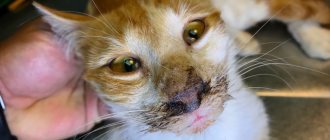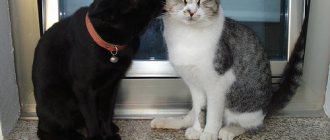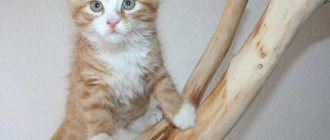Lice eaters are ectoparasites that live on the surface of a cat's body. Unlike fleas, they do not feed on animal blood. By parasitizing on the surface of a cat's body, lice eaters cause a disease called trichodectosis, one of the symptoms of which is itching, causing hair loss and severe scratching on the skin. As a result of parasitism, a cat may develop dermatitis.
What lice eaters look like.
The body size of the lice eater is from 1 to 2 mm. The body has a flat shape. The head is quite large and has a quadrangular shape. The mouthparts are of the gnawing type, very well developed. There are no wings. The lice eater's paws have microscopic sharp claws, with the help of which the parasite moves around the cat's body and does not fall off it. The color is light yellow or gray, the body structure is transparent.
Lice eaters feed on cat hair and tiny particles of skin.
Lice eaters have a high ability to reproduce. The female lice eater lays about a hundred eggs at a time, which are treated with a special sticky liquid, thanks to which the eggs cannot be washed off with water or combed out with a comb.
What danger does lice eaters pose to a cat?.
Lice eaters can be carriers of helminthic diseases (worms in cats).
Through lice, a cat can become infected with one or another infectious disease.
A cat infested with lice eaters can lead to:
- The appearance of anemia.
- Cause an exacerbation of the cat’s existing chronic diseases.
- To the appearance of an allergic reaction to lice bites.
- Patchy baldness appears.
- The body is exhausted.
- The coat becomes unattractive.
What are lice eaters?
Lice-eaters or wool-eaters are parasitic insects belonging to the order of lice. There are different species of lice eaters that infect cattle, sheep, horses, and domestic cats and dogs. In total, about 120 species of these ectoparasites (living on the surface of the body) live in Russia.
The lice beetle is a small beetle with a flat body measuring about 2 mm (some individuals reach 10 mm). These are light yellow insects (as opposed to the dark color of fleas) with six legs, which they use to hold onto the animal's hairs.
They feed on blood, particles of the epidermis, and secretions of the cat’s sebaceous glands. This is a parasite, so it can cause the animal a lot of discomfort, as well as provoke skin scratching, which is a gateway to infections, hyperkeratosis and other diseases.
We recommend reading the article about why a cat may scratch itself until it hurts.
Diagnostics
No special diagnostic procedures are required to make a diagnosis. If desired, the owner of an infected cat can independently visually determine the presence of ectoparasites on its fur before visiting the veterinarian.
Having noticed lice eaters in a cat's fur, it is quite possible to mistake them for fleas. To distinguish lice eaters from fleas, you need to heat the cat's fur (this can be done with a special lamp, near a battery, or simply under the sun's rays). Lice eaters strive for warmth and will crawl to the surface, unlike fleas. It is then that they can be seen using a magnifying glass.
Danger and consequences for cats
Infection with lice eaters is called trichodectosis (mallophagosis). Insects make your cat itchy, so she scratches her skin vigorously. Hair falls out at the site of scratching, and hyperkeratosis may develop - a thickening of the stratum corneum of the epidermis.
The presence of parasites on the body can cause allergic reactions in a cat; if there is a massive infection, the animal becomes lethargic, apathetic, and loses its appetite.
If a cat has chronic pathologies, then infection with lice eaters can provoke their exacerbation.
Lice eaters not only cause pain and discomfort to the cat, but are also carriers of the larvae of other parasitic organisms, for example, the pumpkin or cucumber tapeworm. This tapeworm, which causes the dangerous disease dipilidia, lives not only in the body of animals, but also in humans. This type of helminthiasis can be transmitted from pets to humans through close contact.
Lice eaters under a microscope
What are the symptoms
- Scabies. Cats often begin to itch or bite themselves, trying to get rid of parasites on their own.
- Nervousness. Due to prolonged itching, the pet may become aggressive and nervous. Sometimes the animal is deprived of sleep due to parasites.
- Wounds. When lice eaters terrorize a pet for a long time, multiple bites and scratches become noticeable due to strong scratching.
- Parasites. While petting your pet, you can feel waste products and the insects themselves.
- Dandruff and other consequences. In the habitat of lice eaters, baldness can be found. The pet's fur becomes faded and falls out, and dandruff forms on the skin.
Transmission routes and risk factors
The appearance of lice-eaters is possible at any age, regardless of gender or seasons. Parasites are transmitted by contact when communicating with a carrier. This could be another cat, a dog, large pets and livestock, as well as rodents that the cat hunts. If a mother cat is infected with lice eaters, then they move onto the kittens.
In rare cases, it is possible that eggs or larvae of lice beetles may be transmitted on poorly sterilized tools used by the groomer.
Meeting parasites does not always lead to infection. If the cat receives good care and a balanced diet, then its immunity will allow it to cope with infection.
Animals whose immune systems, for one reason or another, do not function well enough, are at greater risk of contracting parasitic insects. This applies to small kittens and very elderly cats. Immunity may decrease after an infectious disease or surgery.
There are insufficient protective forces in animals that have severe chronic pathologies.
Causes of parasites
The cat lice eater is a parasite that can be acquired even by a healthy cat that does not leave its own home. A good owner needs to know how his pet can pick up dangerous parasites.
There are several ways of infection by lice eaters:
- communication with a sick cat or dog;
- catching a sick rodent;
- infection of kittens from a sick mother;
- poor living conditions for the cat;
- dampness in the room where the cat lives;
- poor cat nutrition.
Symptoms of infection
Signs of infestation with lice eaters are:
- The cat constantly licks itself, itches furiously, bites into the fur with its teeth;
- When examined, scratches, wounds, and bite marks are found on the cat’s body;
- Areas of the body where hair had fallen out and bald spots appeared.
You should also keep an eye on the cat. Symptoms such as lethargy, loss of interest in games, excessive excitability, and restlessness for no apparent reason may indicate infection with parasites.
The cat's character may deteriorate sharply; it stops responding to the words and actions of the owner. Severe skin itching can greatly spoil an animal's mood and even deprive it of sleep.
Help from specialists
If you notice that your dog or cat is constantly and painfully itching, going bald and eating poorly, do not delay a visit to the clinic. Delay in treating lice can lead to the development of eczema, complete baldness and exhaustion of the pet. Decreased immunity can lead to death in the long term.
Specialists from the network of veterinary clinics “Svoy Doctor” will examine your pet, conduct a study and prescribe the optimal treatment. Contact the branch nearest to you in Moscow or another city for help.
Mr. Cat recommends: treatment and care for a sick cat
If you find lice eaters on your pet's fur, you must first show it to a veterinarian. He will examine the cat and determine the type of infection. After this, special means will be prescribed to destroy parasitic insects.
Such drugs contain toxic substances, so they should be used correctly, in recommended dosages. After treating an animal’s fur with an antiparasitic agent, it is recommended to put a special collar on its neck, which will prevent the drug from being licked off and protect the pet from poisoning.
Treatment against lice must be carried out at least twice. Insects lay eggs (nits), which may not be affected by the product. As a rule, adults and larvae die under the influence of the drug the first time.
After about 10 days, the treatment should be repeated to destroy the larvae that have hatched from the eggs, but have not yet reached the adult stage.
If it is not possible to take your cat to the veterinarian, then you can try treatment for lice at home. Parasites can be removed using products sold in pet stores and animal pharmacies.
They are available in the following forms:
- drops (Barrier, Bars, Celandine, Frontline, Hartz);
- sprays (Acaromectin, Bolfo, Frontline);
- special shampoos (Bolfo, Demos Lux, Bars);
- emulsions (Bionix, Merial).
Remedies for ectoparasites can be easily purchased at any pet store, but their use requires great caution. They are toxic and can harm the cat, so when using them you must strictly follow the instructions.
The owner must be especially careful in treating the kitten.
Also, some owners try to cure parasite infestations using traditional methods. They are not as effective as pharmaceutical drugs, but in cases where the disease is detected at the initial stage and there are few insects, they can help. It is recommended to get rid of hairworms using decoctions of plants such as chamomile, string, and wormwood. The cat should be bathed in it.
If there are too many insects and they actively reproduce, then such methods will not have an effect.
If your cat has scratches or lesions on the skin, then after the first treatment with an antiparasitic agent, it is necessary to treat them. The wounds should be washed daily with an antiseptic solution. In cases where the damage is extensive, you can apply a sterile bandage, and then change it regularly after treating with an antiseptic.
Don't let your cat lick its wounds.
In the most severe cases, when damaged skin becomes infected, more serious measures may be required. The doctor may even prescribe a course of antibiotics.
Prevention of lice-eater infestation
Today, special collars containing insecticides and protecting animals from various ectoparasites are becoming increasingly popular. Such accessories can also be used to get rid of ectoparasites, but in this regard they are not so effective. But they can very effectively repel fleas, ticks, lice eaters and other insects that prefer to live on cats.
To prevent parasite infection, it is recommended to follow the following preventive measures:
- regularly use special anti-parasitic shampoos, sprays or drops, treat the animal’s fur, especially if it walks outside;
- periodically inspect your pet (lice eaters are heat-loving insects, so to see them, you need to place the cat closer to the heat source and wait a little);
- periodically wash the bedding and blankets on which the cat prefers to lie;
- undergo regular examinations at a veterinary clinic.
In addition, if possible, the pet should be protected from contact with infected animals, fed rationally, and properly cared for.
Getting rid of lice eaters is not difficult, and it is necessary to do this if the cat is infected. These insects cause serious discomfort to your pet and can cause various diseases. After treatment, you should thoroughly wash the cat’s bed, house and other things, and treat surfaces in the house with an insecticide (with caution to avoid poisoning animals and small children).
1111
Spreading
Lice cannot tolerate high temperatures on the surface of the host's skin, so their populations decline in the summer. The incidence of infection is higher in winter. This is also facilitated by the fact that in winter owners cease to fear attacks from fleas and ticks, which means they stop preventive treatments against parasites.
The pathogen is transmitted during close contact from a sick animal to a healthy one. Infection is promoted by:
- poor care;
- crowded content;
- poor health.
Lice are species-specific, so cats cannot become infected with them from other animal species, only from relatives.
The main differences between fleas and lice:
| Sign | Fleas | Lice and lice eaters |
| Seasonality | In summer | in winter |
| Infection | From any species of mammals, from the external environment | Only in direct contact with relatives |
| Parasitizes the host | 5% of the population (eggs, pupae and larvae in the external environment) | 100% of the population |











